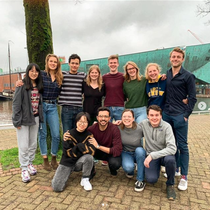The explosion in urban growth presents opportunities as well as challenges to, among others, our food systems. As a result, many cities are exploring how to create liveable and healthy environments for their citizens that also integrate sustainable ways to produce food.
To support these developments and explore the potential of urban farming, Wageningen University & Research (WUR) organizes an Urban Greenhouse Challenge every other year. For this challenge, students world-wide are invited to develop an urban farming business plan to be implemented in one of the world’s major metropoles.
Challenge accepted by teAMSpirit
We’re proud to announce that “teAMSpirit”, a group of students from our master’s degree Metropolitan Analysis Design and Engineering (MADE), Urban Environmental Management and Plant Technology at WUR, and Architecture at TU Delft, took on WURs challenge.
And as of this week this multidisciplinary team is one step closer to turn their innovative ideas into reality... TeAMSpirit is through to the finals!
“We are driven by the need for more resilient and sustainable food systems. Climate change and increasing urban populations increase the pressure on agricultural systems to provide adequate food. Therefore, as a team, we want to be part of providing ideas through real-world innovation.”
teAMSpirit

Designing a greenhouse for a metropolitan area in China
This year, WUR challenged student teams from all over the world to design a business plan for an iconic and circular urban ‘greenhouse’ for a city in China. The requirements for the greenhouse are that it should:
- Produce safe and healthy food for the local neighborhood and commercial markets and;
- Stimulate a healthy lifestyle and interactions with city dwellers.
Furthermore, the concept should take social, economic, environmental and technical aspects into account. Ultimately, the winning design will provide inspiration for a new development project “the Marina Bay Center Agricultural Park”, situated in one of the world’s major metropoles: Guangdong in China.
A urban greenhouse called “the Turtle”
The ecological and economic land use goal of this project and the importance of safe food and the cultural heritage of Dongguan - a city in central Guangdong Province, China - are important starting points for the design of teAMSpirit's greenhouse. Furthermore, among the main challenges currently faced by the urban area includes adapting to climate change, agricultural resilience, and green waste management.
The aim is to incorporate these aspects in their business plan. After the first design phase, TeAMSpirit’s greenhouse concept is nicknamed “the Turtle”:
“In our first designs, the greenhouse resembled a turtle. Did you know that the Chinese culture turtles are among others seen as a symbol of wisdom, endurance, wealth, and long life?”
teAMSpirit

Three pillars that determine the Turtle identity
- Heritage and Innovation: The Turtle is rethinking the future by incorporating elements of Chinese tradition into its design and function. Innovation is found in the farming, educational practices, energy supply, and architectural choices. However, for every innovation, traditions and culture lie at its foundation;
- Society and Knowledge: The Turtle strives to be a bridge between cultures, practices and societies. More than just a building, The Turtle is a platform of various exchanges. Citizens learn from researchers, businesses collaborate with researchers, and the elderly and the young blend in together;
- Health and Transparency: The Turtle provides citizens with open spaces, living labs, social spaces, and a variety of activities to improve physical and mental health. Moreover, as a hub for innovation and knowledge, The Turtle seeks total transparency of its food process and scientific activity. A dialogue between researchers and citizens, as well as business collaborations enable this.
“By conducting a survey among Guangdong citizens and further in-depth research, we validated our assumptions. On this we built our identity, which consist of three main themes.”
TeAMSpirit

A business concept that focuses on food production and circularity
The core business of The Turtle focuses on the production of local, sustainable and safe food. The second key activity is the green power plant, which makes The Turtle circular by producing energy, heat and fertilizer. The research institute will provide trustworthiness to customers and ensure that crop production is the most efficient and exemplary by continuous innovation. Interaction between the world of science and business is facilitated in The Turtle’s Green Business Hub.
High-tech innovation and knowledge will benefit the community through the Living Lab program. In these programs, citizens have the opportunity to actively engage in agriculture processes and participate in co-creation. In addition, people are directly connected to the research institute through the education facilities. incorporated into the building while keeping in mind the need for circularity, sustainability, and innovation.
“To illustrate, our idea is to, among others, have citizens participate in the green exchange program facilitated by the greenhouse in which green waste is collected by citizens who in return receive crops grown in house. Also, the greenhouse facilitates a living lab platform where researchers and citizens connect technology with the societal context.”
teAMSpirit

A Unique Selling Point: 4 seasons in one greenhouse
One of the unique selling points of this business plan is the fact that the students aim to design the urban greenhouse in such a way that all seasons will be simulated in 4 separate greenhouse pods. This creates 4 controllable environments for investigating seasonal crop-sequences. Therefore, this provides an excellent research opportunity to develop a resilient agricultural system including state-of-the-art technology and full circularity.
Overall, the functions of their ‘greenhouse’ are tailored towards the societal context it is situated in. This means that the concept aims to facilitate societal functions, such as providing energy, food, and research insights. It does this by providing the following functions: a high-tech multi-season greenhouse, a R&D center, a living lab platform, a green power plant, facilitating co-creation between science and people, and an attractive shared space.